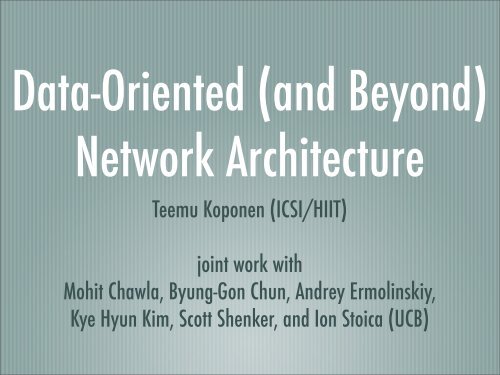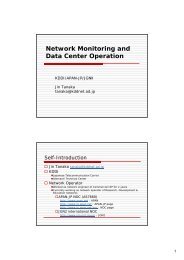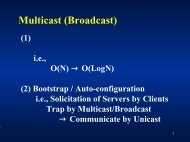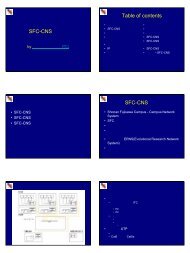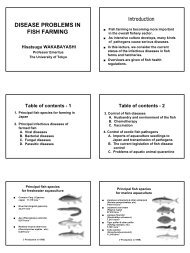Teemu Koponen (ICSI/HIIT) joint work with Mohit Chawla, Byung ...
Teemu Koponen (ICSI/HIIT) joint work with Mohit Chawla, Byung ...
Teemu Koponen (ICSI/HIIT) joint work with Mohit Chawla, Byung ...
- No tags were found...
You also want an ePaper? Increase the reach of your titles
YUMPU automatically turns print PDFs into web optimized ePapers that Google loves.
Data-Oriented (and Beyond)Net<strong>work</strong> Architecture<strong>Teemu</strong> <strong>Koponen</strong> (<strong>ICSI</strong>/<strong>HIIT</strong>)<strong>joint</strong> <strong>work</strong> <strong>with</strong><strong>Mohit</strong> <strong>Chawla</strong>, <strong>Byung</strong>-Gon Chun, Andrey Ermolinskiy,Kye Hyun Kim, Scott Shenker, and Ion Stoica (UCB)
From host-centric to data-centric applications
In the beginning...First applications strictly focused on host-to-hostcommunication:Remote login, file transfer, ...Internet was built around this host-to-host model.Architecture is well-suited for communication betweenpairs of stationary hosts.
... while todayVast majority of Internet usage is data retrieval andservice access.Users care about the content and are oblivious tolocation. Consider:Fetching headlines from CNN, videos from YouTube.Accessing a bank account at “www.bank.com”.
User-relevant issuesPersistence: a data or service name remains validas long as the data or service is available.Authenticity: data came from the appropriatesource, rather than from an adversary.Availability: access to data and services should bereliable and have low-latency.
What do we have today?MechanismsIssue(s)PersistenceAuthenticityAvailabilityDNS, HTTP redirectIPsec, TLS, PKICDNs, P2PMoving acrossdomains.Focus on the channel,not on content.Application specific andad hoc mechanisms.
Basic Design
Related <strong>work</strong>Almost every aspect of our design is borrowed:TRIAD,HIP,SFS, and many others...Our contribution is the synthesis of these ideas into acoherent architecture.
DONA approachHandled byProvided byPersistence Names Flat namesAuthenticity Names Self-certifying namesAvailabilityName resolutionRoute-by-nameparadigm
NamingNames organized around principals.Names are of the form P : L.P is cryptographic hash of principal’s public key, andL is a unique label chosen by the principal.Granularity of naming left up to principals.Names are “flat”.
Self-certifying namesA piece of data comes <strong>with</strong> a public key and a signature.Client can verify the data did come from the principal by1. Checking the public key hashes into P, and2. Validating that the signature corresponds to thepublic key.Challenge is to resolve the flat names into a location.
Name resolutionResolution infrastructure consists of Resolution Handlers.Each domain will have one logical RH.Two primitives FIND(P:L) and REGISTER(P:L).FIND(P:L) locates the object named P:L.REGISTER messages set up the state necessary for theRHs to route FINDs effectively.
Resolution infrastructureREGISTER stateFIND being routedTier-1RHRH RH RHRH RH RHCopy Copy Client
Establishing REGISTER stateAny machine authorized to serve a datum or service <strong>with</strong>name P:L sends a REGISTER(P:L) to its first-hop RH.RHs maintain a registration table that maps a name to bothnext-hop RH and distance (in some metric).REGISTERs are forwarded according to interdomain policies.REGISTERs from customers to both peers and providers.REGISTERs from peers optionally to providers/peers.
Forwarding FIND(P:L)When FIND(P:L) arrives to a RH:If there’s an entry in the registration table, the FIND issent to the next-hop RH.If there’s no entry, the RH forwards the FIND towardsto its provider.In case of multiple equal choices, the RH uses its localpolicy to choose among them.
Application viewpointThere’s no separate lookup/resolving phase forapplications.Client application calls connect(P:L). Client stack:1. Issues a FIND(P:L) to locate an object P:L.2. Also initiates transport exchange <strong>with</strong> FIND(P:L).RH infrastructure routes only the FIND(P:L), while the IPlayer routes the following (data) packets.
ChallengesUsabilitySecurityConcernFlat names are hard toremember.Private keys will getcompromised.ApproachExternal mechanismsneeded.Key revocationmechanism needed.Scalability Huge flat namespace. More shortly...
Using DONA’s functionality
Using name-based anycastName-based anycast is useful as such:Server selection.Mobility and multi-homing.Session initiation.Multicast state establishment.
Extending RH functionalityImproving content delivery:Caching,Subscriptions, andAvoiding misbehaving and overloaded servers.Delay-Tolerant Net<strong>work</strong>ing.Access rules and net<strong>work</strong> imposed middleboxes.
Feasibility
Where is the challenge?RHs need only keep routing state for data that lie belowor equal to it in the AS hierarchy.Toughest requirements on the Tier-1 providers -- belowit’s easy.Only supporting the FIND/REGISTER load critical.All other RH functionality is optional.
Computational requirementsRegistration processing requirements for a single Tier-1 ISP:10 11 names, 42 bytes per name = routing table of 4TB.Registration lifetime 2 weeks = 83000 registrations/s(w/ crypto ops).Forwarding requirements:20000 FINDs/s per every Gbit/s worth of traffic.Name resolution speeds, not packet forwarding speeds!
Required hardwareStoring routing table:In RAM: 500 PCs <strong>with</strong> 8GBs of RAM, orOn Disk: 50 disks per every 1 Gbit/s worth of traffic.What’s the mix and (physical) distribution of RAM anddisk depends on aggregate load and other factors.CPU for Crypto: 40 CPUs running at 3GHz.Reasonable requirements. Consider Sun Blackbox.
Broader ArchitecturalImplications
Raising the API abstraction levelApplications revolve around names of data and services(REGISTER/FIND API), not address/host names (Socket API).Applications shielded from low-level communication details.API semantically similar to a publish/subscribe interface.REGISTER = publish, FIND = subscribe.Is a new pub/sub-based spanning layer emerging?
Thank you! Questions?


